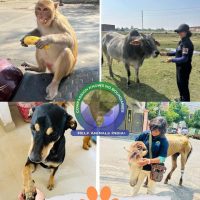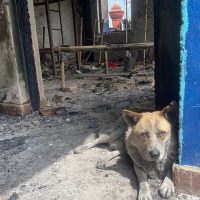Freeing and improving conditions for India's Captive Elephants
CUPA’s Work for the Elephants of India
CUPA (Compassion Unlimited Plus Action) is at the forefront of the effort to expose the unacceptable living conditions of India's estimated 3,500 to 4000 captive elephants and restore these majestic animals to dignified lives in chain free sanctuaries. One of India's major animal welfare organizations, CUPA believes this transition from captivity to freedom can best be achieved by means of a national network of advanced rescue and rehabilitation centers.

Aneesha: freed at last. Her long walk to freedom from a life time of suffering. Donate to help her and more like her as we work to free more of India’s captive elephants.
An Elephant Named Aneesha
Aneesha was kidnapped from the forest as a child, trafficked and forced to work hard labor in the logging industry for nearly 20 years, then spent nearly 20 years enslaved and chained at a temple. Now at 46, she's finally been liberated and living at the WRRC elephant sanctuary.
Surveying India's Captive Elephants
Headquartered in Bangalore, CUPA has been working since 2005 on a comprehensive Captive Elephant Survey of India. Their survey has revealed a disturbing picture of the treatment of captive elephants in India. CUPA has identified unsatisfactory management regimes for the elephants in the private custody of individuals and institutions such as temples and circuses, and CUPA has published a number of progress reports on these disturbing housing and welfare conditions.
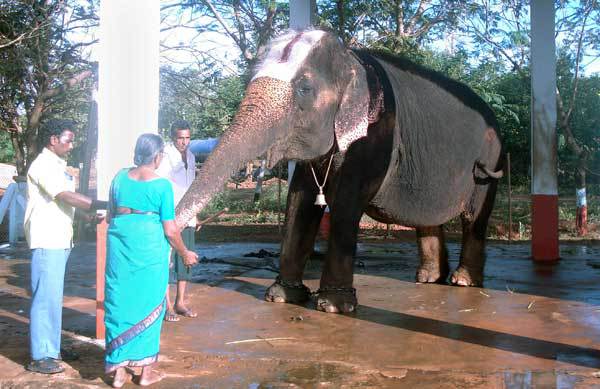
Obese temple elephant on a concrete floor in South India.
The problems, as identified by CUPA, which beset these gentle giants in captivity are many and varied:
HOUSING is deplorable. In the wild, elephants naturally roam for many miles every day. In contrast, India's captive elephants typically are kept in extremely confined, species-inappropriate settings, such as car garages, temple rooms without ventilation, dirty sheds and other polluted, crowded and noisy surroundings. Floors are made of hard materials such as cement, granite and marble. Because of their massive weight, elephants can only stand comfortably – and then only for short periods – on soft, yielding surfaces, such as earth. Their anatomy, physiology and feeding habits are designed for a life of near constant motion, roaming, grazing and foraging over vast tracts of land for 20 or more hours a day. Housing them on hard floors causes chronic pain, severe foot damage and arthritis. In captivity, the elephants also lack access to waterholes or other water bodies. These, too, are essential for their quality of life.
FEED is inadequate and unsuitable - for example, sweets and cooked rice, which are unnatural for elephants and have seriously deleterious effects on their health.
WATER, too, is inadequate and sometimes contaminated. In cities and urban areas, the quantity of drinking water available for captive elephants is much less than the 200 to 250 liters per day these massive animals require. Too often the water is contaminated, since there is a chronic shortage of potable drinking water even for people in most urban areas of India. Often the elephants are hurriedly forced to try and slake their thirst from taps and pipes in public areas. Bathing and wallowing in water also are essential activities for elephants' healthy skin, thermo-regulation and emotional well-being. But this is impossible in urban landscapes without natural lakes or rivers.
EXERCISE is either too much or too little: captive elephants spend most of their lives buffetted between prolonged periods of sedentary confinement when they are not "on the job" and overexertion under unnatural and unhealthful conditions when they are. When confined, they are tied up without exercise. In addition to frustrating their deep-seated instinct to roam, this leads to obesity, arthritis and other health problems. The elephants live like a prisoner who is either penned up in solitary confinement or worked to the point of collapse in an old-fashioned chain gang.
ABUSE AND MISUSE is the daily lot of India's captive elephants. These great animals are exploited for degrading, sometimes abusive purposes, such as begging, performing unnatural acts such as kneeling and blessing devotees (this involves being forced to lift their trunks at least 300 times per day), marching in wedding processions, walking on hot, tarred roads, riding on cycles and playing football. While some of these uses may sound innocuous, typically they subject the elephant to overwork and exhaustion under extremely stressful and unnatural conditions, physical pain and injury, prolonged hunger and thirst, fear and even panic. Every year scores of overstressed elephants run amok at weddings, religious processions or other public festivities, seriously injuring or killing dozens of people. Apart from causing a great deal of discomfort and pain to the animals, very often these activities involve extremely harsh and painful training procedures, as discussed below.

Elephant tied with crude spiked foot belt in Bihar, India.

Commonly used “discipline” and “training” techniques for India’s captive elephants.
TRAINING is essential to control the elephants and make them obey commands. Unfortunately, elephant training has always emphasized punishment over reward, and this is worse than usual today due to a shortage of skilled mahouts (elephant trainers and keepers) in India. As a result, elephants are routinely subjected to brutal training regimes which include starvation, beating with sticks and ankush (elephant hooks that dig into the animals' hides) and tying the elephants up by all four legs. In private captivity, there is a high turnover rate among mahouts, and the elephants must endure adjusting to a new trainer every time. SOCIAL ISOLATION is the norm for India's captive elephants. Some are housed in isolation for their entire lives. For such social and intelligent herd animals, this is the most severe of deprivations, akin to a lifetime of solitary confinement for a human being.
In the course of conducting their Captive Elephant Survey, CUPA researchers learned that some private organizations and establishments were prepared to give up their badly cared for animals to their state forest departments. Unfortunately, this is not a viable option. Most of India's forest departments lack the capacity to take on what they consider to be an "elephantine" responsibility. It is CUPA's view that each state must, instead, make provisions for the establishment of dedicated rescue/care centers for the captive elephants in their territory. Until such centers become a reality, there is an urgent need to improve the level of care for the elephants that remain in private hands.
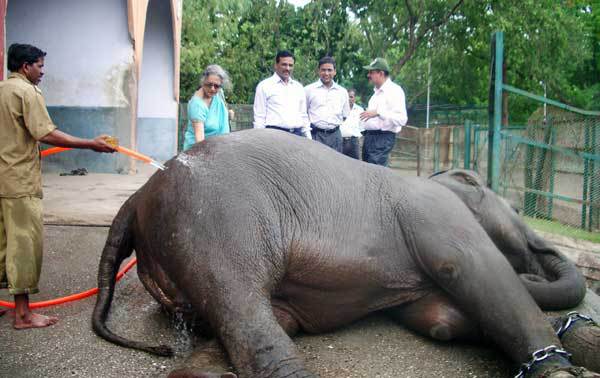
Zoo elephant in central India, without a natural body of water and always on a concrete floor.
An elephant named Menaka
Menaka was rescued from a small Hindu temple after repeated complaints from the public and reports by authorities, including CUPA. The Karnataka state forest department finally confiscated her and handed her over to the Wildlife Rescue and Rehabilitation Centre (WRRC), a sister organization of CUPA dedicated to the welfare of wild animals. Taken from the abusive confines of the temple, Menaka took three years to settle into a routine that has been designed to be as natural and easy for her as possible.
Menaka now spends 16 hours every day in the Bannerghatta National Park. There she gets to socialize with her new friends - other elephants who, though captive too, are left in the park's forest to graze and forage full-time. Occasionally Menaka even meets wild elephants in the park. At the rescue center, where she is brought indoors after her bath and scrub in a nearby water body, Menaka spends the day chewing on green fodder and a snack of fruits and grains before she is returned to the forest at night.
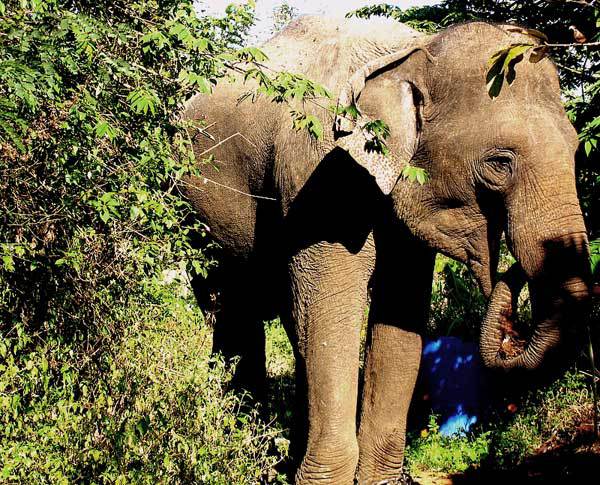
Female temple elephant Menaka in a bamboo grove at rescue center in Bangalore, Karnataka, India, sponsored by CUPA (donations always needed to support her care).
Menaka's gradual adjustment to a nearly natural life has given CUPA the impetus to negotiate with the government for a rescue/care center for elephants in our state of Karnataka. At such a center, some elephants from the zoos could also be admitted for care and rehabilitation. CUPA hopes their vision soon translates into reality. It would serve as a demonstration project for all of India.
Free at Last: from captivity to the wild via rehabilitation centers
In November 2009, the Central Zoo Authority (CZA) of India issued a directive that sent shock waves throughout the global animal welfare community and set a shining precedent for all nations. The CZA banned the keeping of elephants in Indian zoos.
CUPA, in collaboration with the Asian Nature Conservation Foundation, had already produced a comprehensive report titled Captive Elephants in Zoos: An Investigation into the Welfare and Management of Captive Elephants in Zoos in India. Well versed with the limitations that mega species like elephants face in the limited and cramped environment of zoos, the CZA's Committee for the Appraisal of Elephants in Indian Zoos (of which CUPA is a member) has tried to objectively assess the conditions of each zoo and recommend ways to relieve the plight of their captive elephants as they undergo a safe transition from captivity to freedom.
It is well known that a super intelligent mammal that often rivals humans in its intelligence and capacity for grief and other emotions, its complex family structure, its proverbial memory, its occasional use of tools and its very active lifestyle is deeply unhappy and unfulfilled when deprived of space, stimulation and community. The CZA's historic directive is an act of compassion and understanding.
However, the challenge the advisory Committee faces is to convince the CZA that an elephant brought up in confinement for decades is helpless as a child in getting used to forest camp regimes, without the safety net of an interim rehabilitation center.
Though its natural life is in the forest environment, an elephant needs attention, protection and a soft release before being returned to the wilderness where it must interact with its wild counterparts, find the right foods and be able to socialize. All of these skills have been damaged in its infancy and childhood.
Since its lifespan is akin to humans and its stages of growth and maturity parallel a human life, the captive elephant is as lost as its human counterpart would be if he or she had been unschooled in the basic lessons of survival, socializing, communication and other skills essential for survival in human society.
As a member of the Appraisal Team for Zoo Elephants, CUPA hopes to make a strong recommendation to the Government of India for the establishment of elephant rescue centers in the elephant range states so that the zoos where elephants are kept can be relegated to the annals of history and the new care homes become the stepping stones for the rehabilitation of elephants to their rightful heritage – the forests of India.
- Captive Elephants Project - Wildlife Rescue and Rehabilitation Centre
- Watch videos of Menaka and other India elephants taken by the Help Animals India director
Gowri the elephant just rescued with sanctuary for life!
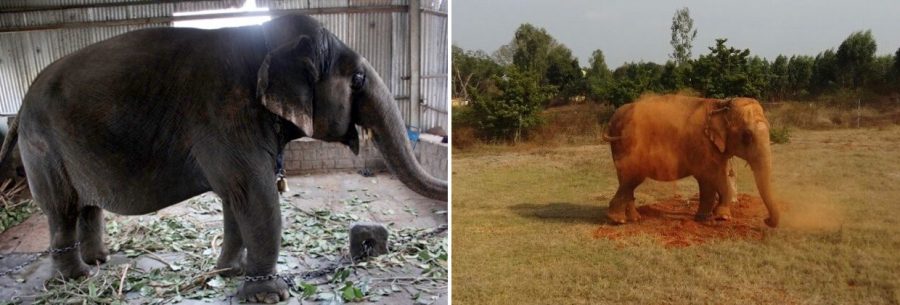
Gowri before and after rescue.
In captivity elephants do not get the proper diet and she has, alas, lost another tooth so special food is prepared. But she continues her great friendship with Aneesha. Their wild existence was stolen from them, when they were trafficked into captivity. Alone, afraid and abused, the decades they spent in commercial captivity have left their mark both physically and mentally, with scars that may take years to heal.
The best we can do, is to love them, care for them and give them the best chance we can at a chain-free life, and advocate strongly to ensure that no other elephant from the wild shares their fate, and others in commercial captivity get a second chance. They are both darlings, help contribute to their and other elephants' care and elephant advocacy if you can!
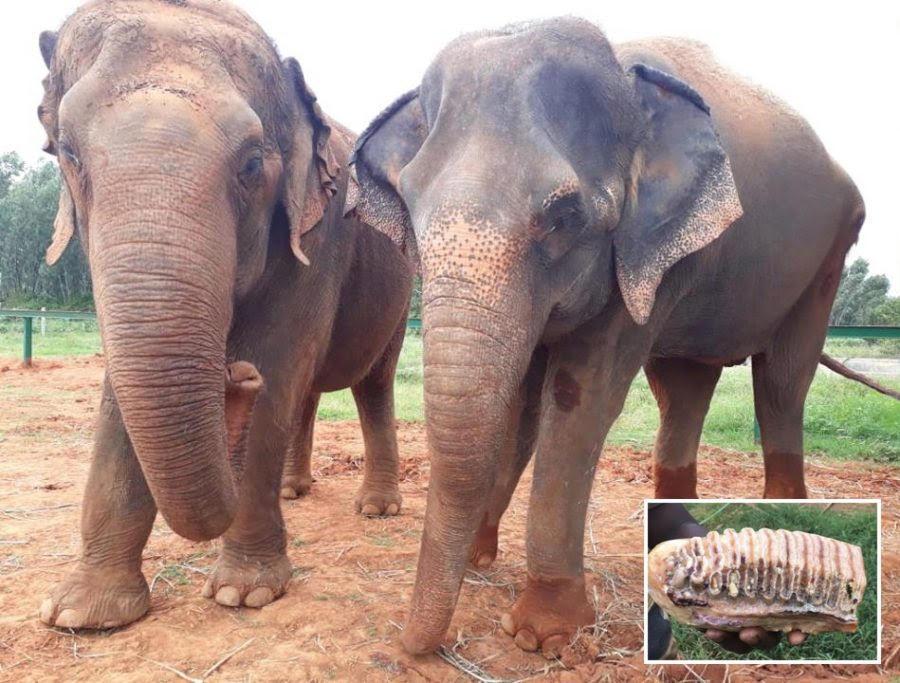
Gowri and Aneesha, best friends! Gowri has lost many teeth from malnourished abused years.

